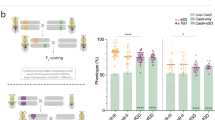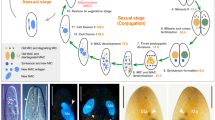Abstract
We have generated a recombinant Mos1 transposon that can insert up to 45-kb transgenes into the Caenorhabditis elegans genome. The minimal Mos1 transposon (miniMos) is 550 bp long and inserts DNA into the genome at high frequency (∼60% of injected animals). Genetic and antibiotic markers can be used for selection, and the transposon is active in C. elegans isolates and Caenorhabditis briggsae. We used the miniMos transposon to generate six universal Mos1-mediated single-copy insertion (mosSCI) landing sites that allow targeted transgene insertion with a single targeting vector into permissive expression sites on all autosomes. We also generated two collections of strains: a set of bright fluorescent insertions that are useful as dominant, genetic balancers and a set of lacO insertions to track genome position.
This is a preview of subscription content, access via your institution
Access options
Subscribe to this journal
Receive 12 print issues and online access
$259.00 per year
only $21.58 per issue
Buy this article
- Purchase on Springer Link
- Instant access to full article PDF
Prices may be subject to local taxes which are calculated during checkout



Similar content being viewed by others
References
Rubin, G.M. & Spradling, A.C. Genetic transformation of Drosophila with transposable element vectors. Science 218, 348–353 (1982).
Brand, A.H. & Perrimon, N. Targeted gene expression as a means of altering cell fates and generating dominant phenotypes. Development 118, 401–415 (1993).
Spradling, A.C. et al. Gene disruptions using P transposable elements: an integral component of the Drosophila genome project. Proc. Natl. Acad. Sci. USA 92, 10824–10830 (1995).
Venken, K.J.T., He, Y., Hoskins, R.A. & Bellen, H.J. P[acman]: a BAC transgenic platform for targeted insertion of large DNA fragments in D. melanogaster. Science 314, 1747–1751 (2006).
Wallrath, L.L. & Elgin, S.C. Position effect variegation in Drosophila is associated with an altered chromatin structure. Genes Dev. 9, 1263–1277 (1995).
Ivics, Z. et al. Transposon-mediated genome manipulation in vertebrates. Nat. Methods 6, 415–422 (2009).
Mello, C.C., Kramer, J.M., Stinchcomb, D. & Ambros, V. Efficient gene transfer in C. elegans: extrachromosomal maintenance and integration of transforming sequences. EMBO J. 10, 3959–3970 (1991).
Praitis, V., Casey, E., Collar, D. & Austin, J. Creation of low-copy integrated transgenic lines in Caenorhabditis elegans. Genetics 157, 1217–1226 (2001).
Bessereau, J.-L. et al. Mobilization of a Drosophila transposon in the Caenorhabditis elegans germ line. Nature 413, 70–74 (2001).
Robert, V. & Bessereau, J.-L. Targeted engineering of the Caenorhabditis elegans genome following Mos1-triggered chromosomal breaks. EMBO J. 26, 170–183 (2007).
Frøkjær-Jensen, C., Davis, M.W., Ailion, M. & Jorgensen, E.M. Improved Mos1-mediated transgenesis in C. elegans. Nat. Methods 9, 117–118 (2012).
Frøkjaer-Jensen, C. et al. Single-copy insertion of transgenes in Caenorhabditis elegans. Nat. Genet. 40, 1375–1383 (2008).
Jinek, M. et al. A programmable dual-RNA-guided DNA endonuclease in adaptive bacterial immunity. Science 337, 816–821 (2012).
Chen, C., Fenk, L.A. & de Bono, M. Efficient genome editing in Caenorhabditis elegans by CRISPR-targeted homologous recombination. Nucleic Acids Res. 41, e193 (2013).
Dickinson, D.J., Ward, J.D., Reiner, D.J. & Goldstein, B. Engineering the Caenorhabditis elegans genome using Cas9-triggered homologous recombination. Nat. Methods 10, 1028–1034 (2013).
Friedland, A.E. et al. Heritable genome editing in C. elegans via a CRISPR-Cas9 system. Nat. Methods 10, 741–743 (2013).
Lohe, A.R. & Hartl, D.L. Efficient mobilization of mariner in vivo requires multiple internal sequences. Genetics 160, 519–526 (2002).
Lozovsky, E.R., Nurminsky, D., Wimmer, E.A. & Hartl, D.L. Unexpected stability of mariner transgenes in Drosophila. Genetics 160, 527–535 (2002).
Horn, C. & Wimmer, E.A. A versatile vector set for animal transgenesis. Dev. Genes Evol. 210, 630–637 (2000).
Casteret, S. et al. Physical properties of DNA components affecting the transposition efficiency of the mariner Mos1 element. Mol. Genet. Genomics 282, 531–546 (2009).
Boulin, T. & Bessereau, J.-L. Mos1-mediated insertional mutagenesis in Caenorhabditis elegans. Nat. Protoc. 2, 1276–1287 (2007).
Liu, T. et al. Broad chromosomal domains of histone modification patterns in C. elegans. Genome Res. 21, 227–236 (2011).
Meyer, B.J. Targeting X chromosomes for repression. Curr. Opin. Genet. Dev. 20, 179–189 (2010).
Seth, M. et al. The C. elegans CSR-1 argonaute pathway counteracts epigenetic silencing to promote germline gene expression. Dev. Cell 27, 656–663 (2013).
Shirayama, M. et al. piRNAs initiate an epigenetic memory of nonself RNA in the C. elegans germline. Cell 150, 65–77 (2012).
Wedeles, C.J., Wu, M.Z. & Claycomb, J.M. Protection of germline gene expression by the C. elegans argonaute CSR-1. Dev. Cell 27, 664–671 (2013).
Vallin, E. et al. A genome-wide collection of Mos1 transposon insertion mutants for the C. elegans research community. PLoS ONE 7, e30482 (2012).
Lohe, A.R. & Hartl, D.L. Efficient mobilization of mariner in vivo requires multiple internal sequences. Genetics 160, 519–526 (2002).
Maduro, M. & Pilgrim, D. Identification and cloning of unc-119, a gene expressed in the Caenorhabditis elegans nervous system. Genetics 141, 977–988 (1995).
Giordano-Santini, R. et al. An antibiotic selection marker for nematode transgenesis. Nat. Methods 7, 721–723 (2010).
Semple, J.I., Garcia-Verdugo, R. & Lehner, B. Rapid selection of transgenic C. elegans using antibiotic resistance. Nat. Methods 7, 725–727 (2010).
Radman, I., Greiss, S. & Chin, J.W. Efficient and rapid C. elegans transgenesis by bombardment and hygromycin B selection. PLoS ONE 8, e76019 (2013).
Kelly, W.G., Xu, S., Montgomery, M.K. & Fire, A. Distinct requirements for somatic and germline expression of a generally expressed Caenorhabditis elegans gene. Genetics 146, 227–238 (1997).
Andersen, E.C. et al. Chromosome-scale selective sweeps shape Caenorhabditis elegans genomic diversity. Nat. Genet. 44, 285–290 (2012).
Zhao, Z. et al. New tools for investigating the comparative biology of Caenorhabditis briggsae and C. elegans. Genetics 184, 853–863 (2010).
Sarov, M. et al. A recombineering pipeline for functional genomics applied to Caenorhabditis elegans. Nat. Methods 3, 839–844 (2006).
Maydan, J.S. et al. Efficient high-resolution deletion discovery in Caenorhabditis elegans by array comparative genomic hybridization. Genome Res. 17, 337–347 (2007).
Maydan, J.S., Okada, H.M., Flibotte, S., Edgley, M.L. & Moerman, D.G. De novo identification of single nucleotide mutations in Caenorhabditis elegans using array comparative genomic hybridization. Genetics 181, 1673–1677 (2009).
Robinett, C.C. et al. In vivo localization of DNA sequences and visualization of large-scale chromatin organization using Lac operator/repressor recognition. J. Cell Biol. 135, 1685–1700 (1996).
Groth, A.C., Fish, M., Nusse, R. & Calos, M.P. Construction of transgenic Drosophila by using the site-specific integrase from phage ϕC31. Genetics 166, 1775–1782 (2004).
Sarov, M. et al. A genome-scale resource for in vivo tag-based protein function exploration in C. elegans. Cell 150, 855–866 (2012).
Semple, J.I., Biondini, L. & Lehner, B. Generating transgenic nematodes by bombardment and antibiotic selection. Nat. Methods 9, 118–119 2012).
Meister, P., Towbin, B.D., Pike, B.L., Ponti, A. & Gasser, S.M. The spatial dynamics of tissue-specific promoters during C. elegans development. Genes Dev. 24, 766–782 (2010).
Chen, C., Fenk, L.A. & de Bono, M. Efficient genome editing in Caenorhabditis elegans by CRISPR-targeted homologous recombination. Nucleic Acids Res. 41, e193 (2013).
Wei, X., Potter, C.J., Luo, L. & Shen, K. Controlling gene expression with the Q repressible binary expression system in Caenorhabditis elegans. Nat. Methods 9, 391–395 (2012).
Brenner, S. The genetics of Caenorhabditis elegans. Genetics 77, 71–94 (1974).
Gibson, D.G. et al. Enzymatic assembly of DNA molecules up to several hundred kilobases. Nat. Methods 6, 343–345 (2009).
Acknowledgements
We thank B. Waterston (University of Washington), A. Sapir and P. Sternberg (California Institute of Technology), and the NemaGENETAG consortium for strains; B. Meyer (UC Berkeley) and P. Meister (University of Bern) for validating lacO insertions; the J. Chin (MRC, University of Cambridge), D. Dupuy (University of Bordeaux), B. Lehner (EMBL-CRG, Systems Biology Unit, Barcelona) and G. Seydoux (John Hopkins University) labs for plasmids; M. Maduro (UC Riverside) for improving mosSCI insertion frequency; and K. Hoe for expert technical assistance. Some strains were provided by the Caenorhabditis Genetics Center (CGC), which is funded by US National Institutes of Health (NIH) Office of Research Infrastructure Programs (P40 OD010440). This work was supported by the Carlsberg Foundation (C.F.-J.), NIH grant 1R01GM095817 (E.M.J.), US National Science Foundation grant NSF IOS-0920069 (E.M.J.) and the Howard Hughes Medical Institute (E.M.J.). The Mosmid engineering work was supported by the Max Planck Society (MPG) Initiative “BAC TransgeneOmics” and the NIH ModENCODE project. Work in the laboratory of D.G.M. was supported by the Canadian Institute for Health Research. Work in the laboratory of D.G.M. was supported by the Canadian Institute for Health Research and the Canadian Institute for Advanced Research.
Author information
Authors and Affiliations
Contributions
C.F.-J. designed experiments under the supervision of E.M.J. and M.W.D. C.F.-J., M.S., A.P., J.T., M.L. and S.F. performed the research. C.F.-J. performed molecular biology, injections, imaging and genetics; M.L. generated mapping strains; M.S. and A.P. performed fosmid recombineering; and J.T., S.F. and D.G.M. performed comparative genome hybridization. C.F.-J. and E.M.J. wrote the paper with input from all coauthors.
Corresponding authors
Ethics declarations
Competing interests
The authors declare no competing financial interests.
Supplementary information
Supplementary Text and Figures
Supplementary Figures 1–9, Supplementary Note and Supplementary Protocols (PDF 1861 kb)
Supplementary Table 1
Strains, Plasmids, Oligos and Universal insertion sites (XLSX 318 kb)
Source data
Rights and permissions
About this article
Cite this article
Frøkjær-Jensen, C., Davis, M., Sarov, M. et al. Random and targeted transgene insertion in Caenorhabditis elegans using a modified Mos1 transposon. Nat Methods 11, 529–534 (2014). https://doi.org/10.1038/nmeth.2889
Received:
Accepted:
Published:
Issue Date:
DOI: https://doi.org/10.1038/nmeth.2889
This article is cited by
-
ATFS-1 counteracts mitochondrial DNA damage by promoting repair over transcription
Nature Cell Biology (2023)
-
Maternal aging increases offspring adult body size via transmission of donut-shaped mitochondria
Cell Research (2023)
-
Genomic architecture of 5S rDNA cluster and its variations within and between species
BMC Genomics (2022)
-
Cell-type-specific profiling of loaded miRNAs from Caenorhabditis elegans reveals spatial and temporal flexibility in Argonaute loading
Nature Communications (2021)
-
A somatic proteoglycan controls Notch-directed germ cell fate
Nature Communications (2021)



